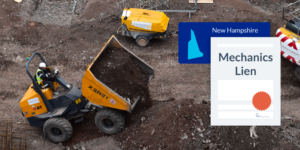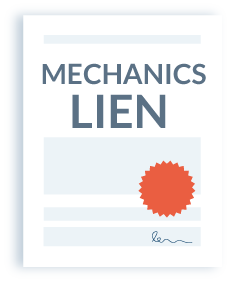
As in all states, New Hampshire contractors, subcontractors, and suppliers are not unarmed when it comes to payment disputes. If they’re not getting paid for work they completed on a construction project, they’re entitled to file a mechanics lien, just like anywhere else. But, the method of how to file a mechanics lien in New Hampshire isn’t quite so standard.
Filing a mechanics lien in New Hampshire requires a step or two more, as well as a strange timeline to follow. Keep reading to learn how to file a mechanics lien in New Hampshire.
New Hampshire lien rights requirements
Some of New Hampshire’s lien rights requirements are very similar to other states, while some are definitely not.
You have to send preliminary notices
Subcontractors, sub-subs, and suppliers have to send a preliminary notice on private projects in New Hampshire. General contractors and contractors in direct contract with the property owner don’t have to send a preliminary notice.
The Granite State’s lien statutes require contractors to send these notices prior to delivery of labor or materials to the project. But practically speaking, there is a bit of leeway here. You can serve preliminary notice up until the point you file the lien, but it’s not likely to protect the entire contract amount at that point.
Preliminary notices are not a requirement on public jobs, but it’s always a good idea to send them anyway.
You have to check in with the project owner every 30 days
While the license plates might say “Live Free or Die,” contractors aren’t quite so free to come and go. Every 30 days, New Hampshire contractors must submit a written account of labor and material furnished for the 30 days prior. This is one of those unique New Hampshire rules.
While this might seem like a pain, it serves the project owner and the contractor. The project owner is always aware of the progress on the site, and is then expected to maintain the ability to pay the contractor in that amount thereafter. It might seem like a small detail, but it does help with the mechanics lien lawsuit.
You don’t have to send a Notice of Intent to Lien
According to New Hampshire mechanics lien law, contractors and suppliers on any tier do not have to send a Notice of Intent to Lien to preserve their lien rights. While an NOI is optional, they do serve as visibility documents that could speed up the payment process, so sending them is always a good idea.
Contractors have 120 days to file a lien
This one’s pretty straightforward. Contractors have up to 120 days of last furnishing of materials or labor to file a mechanics lien. Nothing to it, right? Hold on…
You have to file a lawsuit first
Here’s the big, strange curveball that New Hampshire mechanics lien laws throw at contractors. To file a mechanics lien in New Hampshire, you must first file a lawsuit. Once the court approves the lawsuit, you’re able to file the lien.
Not only is this unorthodox compared to other states, but it could also throw off that 120-day window. If the court hasn’t approved the lawsuit in time, it could drag you out past your lien deadline.
One thing to note is that you can file an Ex Parte Petition to Secure Mechanics Lien. That means, among other things, that you don’t have to serve the other party in order to have your lawsuit approved. However, this is a very specific civil procedure only available in limited circumstances.
Enforcement deadlines are different, too
In most states, you’ll have a certain amount of time to begin enforcing the lien before it expires. But you’ve technically already started enforcing the lien prior to filing it, since the law requires you to file a lawsuit first. That Ex Parte Petition to Secure Mechanics Lien essentially handles this requirement altogether.
How to file a mechanics lien in New Hampshire: Step-by-Step
Compared to other states, those are some different requirements for filing a mechanics lien. Let’s assume you’ve met the preliminary notice and monthly progress report requirements and you’re experiencing a payment dispute or just painfully slow payment. A lien might be the only way to recover that cash. Here’s how to file a mechanics lien in New Hampshire, step-by-step.
Step 1: File a lawsuit, Ex Parte
In New Hampshire, the first step to filing a mechanics lien is to file a lawsuit. In other states, the lawsuit typically comes subsequent to the mechanics lien, but not New Hampshire.
You have up to 120 days from last furnishing to file an Ex Parte Petition to Secure a Mechanics Lien, but it’s very important to leave enough time to get approved and file the lien. Waiting until the last minute could cost you your lien rights.

Step 2: File a lien with the county clerk
When the court approves your petition to file a mechanics lien, you can finally file one. To do so, you need to head to the county clerk’s office of the county where the project is located. Where you live or where your business is based does not matter; it’s all about the job location.
Filing a lien has to occur within the same 120-day window as the petition to file a lien, so there really isn’t any time to waste. Your window doesn’t extend pending the court’s decision, so once again, be sure to leave enough time to accomplish both.
Step 3: Have the lien served upon the property owner
After you file a mechanics lien in New Hampshire, you’ll have to serve the lien upon the property owner. How and when you serve it is up to you, but it’s best to do so as early as possible.
Mechanics liens are incredibly powerful tools and they’re the fastest way to speed up slow payments or settle disputes. Mechanics liens make the property far less liquid, and they also make it difficult for the owner to secure further financing. Throwing that mechanics lien wrench in the works can seriously derail their plans for the property.
The earlier a project owner receives the lien notice, the sooner they’ll have the opportunity to make good on the payments. For this reason, it’s important to have your lien served upon the property owner as soon as possible.
Step 4: Proceed with the lawsuit or remove the lien
At this stage in the game, you can either proceed with the lawsuit to foreclose upon the lien or remove it.
If you decide to move forward with the lawsuit, you’ll have all the documentation necessary to make a strong case, thanks to abiding by preliminary law statutes and the monthly check-ins. Those invoices will come in handy if you show up in court and explain that the project owner should have been putting this money aside each month.
Or, more likely, the project owner will make good on the lien amount. After all, their project becomes much more challenging to manage with the lien looming over it. Should that be the case, you can head back to the county recorder’s office and remove the lien from the property.
New Hampshire might be different, but lien rights are lien rights
The steps to securing your lien rights in New Hampshire are unique, and they might even seem complicated. But lien rights are lien rights, so in the event of a payment dispute, there can always be recourse. Just be sure to follow the unique rules behind New Hampshire mechanics lien laws, and you’ll be on your way to recovering your cash and protecting your business.

File a lien now!
Levelset takes all of the guesswork out of the filing process. We’ll research the project information and ensure your claim is done right.
